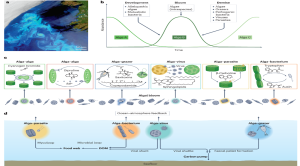
Evolutionary Role of Metacaspase Proteins in UAE Harmful Algal Blooms
Harmful algal blooms (HABs) represent a significant environmental challenge, posing threats to marine ecosystems, human health, and local economies. These blooms, primarily caused by the rapid growth of certain algae species, result in the production of toxins that can lead to massive fish kills, contamination of seafood, and detrimental effects on water quality. In the United Arab Emirates (UAE), HABs are a recurring issue, with species such as dinoflagellates (Marglefidiniumpolykrikoides, Prorocentrum minimum) and diatoms (Chaetocerostenuissimus, Fragilaria radians, Phaeodactylum tricornutum, Skeletonema marinoi) being the primary culprits. The role of metacaspase proteins in these organisms has recently come under scrutiny for their potential involvement in the pathogenicity and toxicity of HABs.These proteases are involved in numerous cellular processes, including apoptosis-like cell death and the regulation of immune responses. Understanding the evolutionary relationships between diatoms and dinoflagellates based on metacaspase proteins is essential for developing effective monitoring and mitigation strategies for HABs. The primary objective of the study made by researchers of Fujairah research Centre is to explore the evolutionary relationships among diatoms and dinoflagellates based on metacaspase protein sequences. This exploration seeks to provide a comprehensive understanding of how these proteins have evolved across different species and how their functional roles might contribute to the occurrence and severity of HABs. By employing comparative genomic and phylogenetic analyses, this research aims to shed light on the similarities and differences in metacaspase proteins among harmful algal species, ultimately contributing to the development of better monitoring and control methods for HABs in the UAE.
Metacaspase protein sequences from various diatoms and dinoflagellates were obtained from the National Center for Biotechnology Information (NCBI). The species selected for this study included known HAB-forming organisms in the UAE waters, such as Marglefidiniumpolykrikoides, Prorocentrum minimum, Chaetocerostenuissimus, Fragilaria radians, Phaeodactylum tricornutum, and Skeletonema marinoi. These sequences served as the basis for subsequent comparative and phylogenetic analyses. The Basic Local Alignment Search Tool (BLAST) was used to compare metacaspase protein sequences across different species. Multiple BLAST experiments were conducted to assess the sequence similarity and evolutionary relationships between the metacaspase proteins of diatoms and dinoflagellates. The results from BLAST searches were used to construct a sequence similarity matrix, which provided insights into the degree of conservation and divergence among the metacaspase proteins. To visualize the evolutionary relationships among the metacaspase proteins, a phylogenetic tree was constructed using sequence alignment data. Multiple sequence alignment was performed using Clustal Omega, and the aligned sequences were used to build a phylogenetic tree with the Neighbor-Joining method. The tree was annotated to highlight the relationships between different species and to identify potential evolutionary lineages within the metacaspase protein family. The BLAST analysis revealed significant alignments between the metacaspase proteins of various diatoms and dinoflagellates. For instance, the metacaspase proteins of Chaetocerostenuissimus showed strong similarity to those of Phaeodactylum tricornutum, Fragilaria radians, and Skeletonema marinoi. Similarly, significant similarities were observed between the metacaspase proteins of Prorocentrum minimum and Marglefidiniumpolykrikoides.The phylogenetic analysis indicated distinct evolutionary lineages within the metacaspase protein family. The family lineage tree showed that Skeletonema marinoi, Marglefidiniumpolykrikoides, and Prorocentrum minimum are evolutionarily closer compared to other diatoms.The study highlights the evolutionary relationships and functional similarities among metacaspase proteins in diatoms and dinoflagellates. These findings contribute to our understanding of the role of metacaspase proteins in HABs and provide a basis for developing targeted strategies to monitor and mitigate the impact of these blooms in UAE waters. Further research incorporating additional molecular markers and experimental validation is needed to enhance our understanding of the evolutionary dynamics and functional implications of metacaspase proteins in harmful algal blooms.
For more detailed information, read the full article by Maryam Alhefeiti, Shaher Bano Mirza, and Fouad Lamghari Ridouane in the International Journal of Development Research: "Exploring the Evolutionary Relationships and Impact of Metacaspase Proteins in Harmful Algal Blooms in the UAE Waters" https://doi.org/10.37118/ijdr.26971.07.2023.
